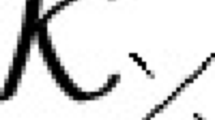Abstract
Let (G, χ, x) be a triple consisting of a finitely presented groupG, epimorphism χ:G →Z, and distinguished elementx ∈G such that χ(x)=1. Given a finite symmetric groupS r, we construct a finite directed graph Γ that describes the set Φ r of representations π: Ker χ →S r as well as the mapping σ x :Φ r →Φ r defined by (σ x ϱ)(a) = ϱ(x −1 ax) for alla ∈ Ker χ. The pair (Φ r ,σ x has the structure of a shift of finite type, a well-known type of compact 0-dimensional dynamical system. We discuss basic properties and applications of therepresentation shift (Φ r ,σ x ), including applications to knot theory.
Similar content being viewed by others
References
[BaSo] G. Baumslag and D. Solitar,Some two-generator one-relator non-Hopfian groups, Bulletin of the American Mathematical Society68 (1962), 199–201.
[BiNeSt] R. Bieri, W. D. Neumann and R. Strebel,A geometric invariant of discrete groups, Inventiones mathematicae90 (1987), 451–477.
[BiSt] R. Bieri and R. Strebel,Almost finitely presented soluble groups, Commentarii Mathematici Helvetici53 (1978), 258–278.
[GoWh] F. González-Acuna and W. Whitten,Imbeddings of 3-manifold groups, Memoirs of the American Mathematical Society474 (1992).
[HaKe] J. C. Hausmann and M. Kervaire,Sous-groupes dérivés des groupes de noeuds, L'Enseignement Mathématique24 (1978), 111–123.
[LiMa] D. Lind and B. Marcus,An Introduction to Symbolic Dynamics and Coding, Cambridge University Press, Cambridge, 1995.
[LySc] R. C. Lyndon and P. E. Schup,Combinatorial Group Theory, Springer-Verlag, Berlin, 1977.
[Ra] E. S. Rapaport,Knot-like groups, in Annals of Mathematical Studies84, Princeton University Press, Princeton, 1975, pp. 119–133.
[Re] B. Renz,Geometric invariants and HNN-extensions, inGroup Theory (Proceedings of a Conference in Singapore, 1987), de Gruyter, Berlin, 1989, pp. 465–484.
[Ro] D. Rolfsen,Knots and Links, Mathematics Lecture Series7, Publish or Perish, Inc., Berkeley, 1976.
[Si1] D. S. Silver,Augmented group systems and n-knots, Mathematische Annalen296 (1993), 585–593.
[Si2] D. S. Silver,Knot invariants from topological entropy, Topology and its Applications61 (1995), 159–177.
[Si3] D. S. Silver,Growth rates of n-knots, Topology and its Applications42 (1991), 217–230.
[Th] W. P. Thurston,Three-dimensional manifolds, Kleinian groups and hyperbolic geometry, Bulletin of the American Mathematical Society6 (1982), 357–381.
Author information
Authors and Affiliations
Corresponding author
Rights and permissions
About this article
Cite this article
Silver, D.S., Williams, S.G. Augmented group systems and shifts of finite type. Israel J. Math. 95, 231–251 (1996). https://doi.org/10.1007/BF02761041
Received:
Issue Date:
DOI: https://doi.org/10.1007/BF02761041



